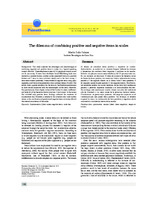Mostrar el registro sencillo del ítem
The dilemma of combining positive and negative items in scales
| dc.contributor.author | Solís-Salazar, Martín | |
| dc.date.accessioned | 2017-04-03T22:18:40Z | |
| dc.date.available | 2017-04-03T22:18:40Z | |
| dc.date.issued | 2015 | |
| dc.identifier | 10.7334/psicothema2014.266 | |
| dc.identifier.citation | es | |
| dc.identifier.issn | 0214-9915 | |
| dc.identifier.uri | https://hdl.handle.net/2238/6927 | |
| dc.identifier.uri | ||
| dc.description.abstract | Background: This study analyzed the advantages and disadvantages of combining negative and positive items in scales in a Spanish-speaking context. Method: Three telephone surveys of 233 people each were carried out. In one survey, 15 items from the Keyes Social Well-Being Scale were worded in a positive fashion; another survey presented 8 items in a positive fashion and 7 items in terms of direct denial; and in the third survey, 7 items were worded positively, 5 were worded in negative terms using polar opposites, and 3 terms were presented in terms of direct denial. Results: The results show a greater tendency for the items in the Positive questionnaire to show results associated with the directionality of the items. However, this questionnaire shows higher values of the Cronbach’s alpha coeffi cient, and better fi t of the theoretical factor structure. Conclusions: In the survey that included only positive items, fi ndings indicated the existence of acquiescence bias. However, a remedy to this situation only made matters worse, as the combination of positive an | es |
| dc.language.iso | eng | es |
| dc.publisher | Colegio Oficial de Psicologos Asturias | es |
| dc.rights | acceso abierto | es |
| dc.rights.uri | https://creativecommons.org/licenses/by-nc/3.0/cr/ | * |
| dc.source | Salazar, M. S. (2015). The dilemma of combining positive and negative items in scales. Psicothema, 27(2), 192-200. | |
| dc.subject | Psicometría | es |
| dc.subject | Encuestas | es |
| dc.subject | Research Subject Categories::SOCIAL SCIENCES::Social sciences::Psychology::Applied psychology | es |
| dc.title | The dilemma of combining positive and negative items in scales | es |
| dc.type | artículo original | es |
Ficheros en el ítem
Este ítem aparece en la(s) siguiente(s) colección(ones)
-
Artículos [9]



